You can read more about the projects on the Chalmers Open Digital Repository, or click the direct links in the items below.
Searching for Scalar Wave Dark Matter with Levitated Magnetomechanics Sensitivity Studies for a Hypothetical Direct Detection Experiment Using Superconducting Levitating Objects
by Amanda Carlsson
2023
This thesis investigates the light scalar boson, with mass between 1.24 · 10−13 and 4.14 · 10−12 eV, as a wave dark matter candidate. For such low masses, the bosons can be described as a classical wave instead of individual particles, which motivates a field description of the dark matter. The scalar boson is assumed to interact only with neutrons in a charge-neutral test object, giving it a time-dependent EP violating acceleration that can be detected in a direct detection experiment. The focus of this thesis was to develop a theoretical and statistical framework for the scalar boson by deriving this EP-violating acceleration, and applying the principle of detection to a potential experiment at Chalmers University of Technology using levitated magnetomechanics. The achievable experimental sensitivity could then be estimated for the hypothetical experiment with analytic derivations of exclusion and discovery limits for the scalar-neutron coupling constant. The purpose of the limits was to determine for which values of the coupling constant the dark matter candidate could be detected or not, and they were derived analytically with the help of a likelihood formalism utilising the so called Asimov data set. Comparing the results with a similar analysis done for the same dark matter candidate, the achievable sensitivity for the proposed magnetic levitation experiment could be concluded to be relatively high.
Searching for Vector Wave Dark Matter with Levitated Magnetomechanics Analysis of a Hypothetical Direct Detection Experiment Using Levitating Superconductive Test Objects
by Måns Anduri
2023
This master’s thesis investigates the sensitivity of a hypothetical direct detection experiment using levitated magnetomechanics for a vector bosonic wave dark matter candidate. The sensitivity studies done is for masses between 1.24 · 10−13 eV and 4.14 · 10−12 eV and with four different possible background terms, where the background is assumed to be thermally based. The vector boson is described with the Lagrangian, L = − 1 4 FµνF µν− 1 2m2 DMAµAµ+gAµnγ¯ µn, and couples to the baryon number minus the lepton number, thus yielding an EP-violating force on a charge neutral test object. Since it is ultralight it can be seen as a classical wave. To measure the sensitivity, the exclusion and discovery limits for the coupling constant, g, are asymptotically derived with the Asimov data set for 95% confidence interval and the 5σ level respectively. The limits are plotted against the mass scanned over and compared with the discovery limit for an optomechanical experiment for the same dark matter candidate. It is shown that the sensitivity for the most optimistic background is comparable with said experiment.
Accelerating computations for dark matter direct detection experiments via neural networks and GPUs
by Hanna Olvhammar
2022
There is indisputable evidence for the existence of dark matter (DM). Examples are the rotation curves of galaxies, the velocity dispersions of galaxy clusters and dark matter density measurements. One of the biggest questions in physics today con cerns the nature of dark matter, and the most promising theory is that dark matter consists of one or more new particle species. To discover the nature of dark matter particles, they need to be inferred from collider experiments or found via indirect or direct detection. Since none of these alternatives has led to conclusive results within the current theoretical frameworks, new approaches should be investigated. In this thesis, sub-GeV dark matter particles are studied through interactions in direct de tection experiments described with an effective field theory (EFT). More specifically, dark matter-induced electronic transition rates in crystal detectors are studied. The rate of electronic transitions is described with EFT scattering amplitudes, which introduce many model-independent coupling strengths. By computing transition rates corresponding to different sets of EFT parameters, direct detection data can be used for inferring properties of dark matter particles without relying on any specific theoretical framework. Since the computation of the electronic transition rates is very expensive, the aim of this thesis is to implement a deep neural network for fast predictions of transition rates. Furthermore, since the neural network re quires a large data set for training, the generation of training data was accelerated using computations on graphics processing units (GPUs). I developed two neural networks, one with the DM mass as input and one with the DM mass and two EFT coupling strengths as inputs, that are about 600 times faster than the original computations and capture the overall behaviour of the transition rates. However, the relative error of the predictions has a standard deviation of about 30% with a mean of around 0%. On the other hand, the GPU computations are about 16 times faster than the original computations and have negligible error while being able to compute transition rates corresponding to all 28 coupling strengths. I conclude that there is great potential for using both neural networks and GPUs for dark matter research, and suggest further improvements.
Bayesian History Matching of Chiral Effective Field Theory in the Two-Nucleon Sector
by Eleanor May
2022
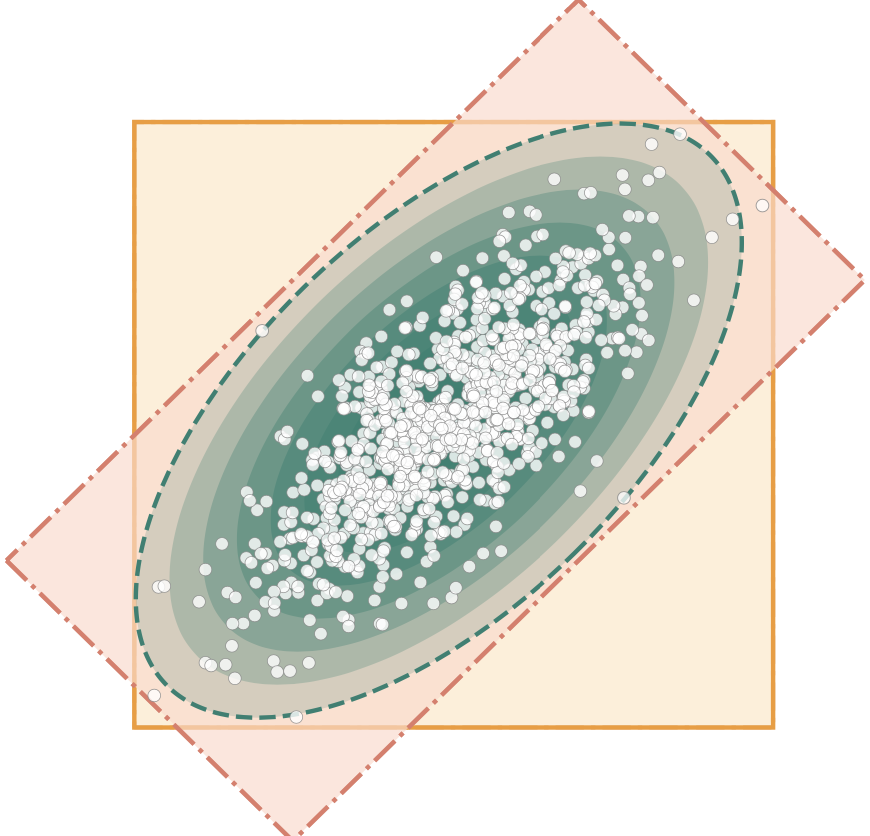
The accurate calculation of nucleon-nucleon scattering observables from first principles is an ongoing challenge within nuclear physics. Working within the framework of chiral effective field theory provides a method for calculating such observables. This is achieved through the construction of an effective Lagrangian that maintains the symmetries of quantum chromodynamics (QCD). In this thesis, truncation of the Lagrangian is performed using a modified Weinberg power counting, introducing a set of unknown low-energy constants at each order in the chiral expansion.
Bayesian history matching is used to explore the leading order description of the nucleon-nucleon system. This is achieved through the iterative reduction of the four-dimensional parameter space, taking a Bayes linear approach. The history matching implementation is validated on the nuclear liquid drop model. Several novel methods of sampling are introduced within the implementation with the purpose of capturing correlations between parameters; The generation of ellipsoidal distributed samples is shown to be the most successful. History matching is subsequently applied to the proton-neutron scattering problem. We identify the subset of parameter space containing all low-energy constants that produce model outputs consistent with experimental two-nucleon scattering data, accounting for relevant sources of uncertainty. Non-implausible parameter volumes are obtained across a range of momentum regulator cutoffs. Finally, non-implausible samples are used to predict the deuteron binding energy. Results indicate that the inclusion of this observable within the history match could further constrain the volumes.
The analysis performed in this thesis was successful in producing sets of non-implausible samples. Such sets can be subsequently used as a starting point for a full Bayesian analysis, with the aim of producing posterior probability distributions. For example, the samples can be used to initialise walkers within the Markov Chain Monte Carlo method.
Parallelization of computational tools for the no core shell model
by Johannes Hansson
2022
The many-body Schrödinger equation is of fundamental importance in nuclear physics. It can be (approximately) solved by employing the no core shell model (NCSM). Using this numerical method in nuclear simulations is a computationally heavy task that requires powerful computer hardware and purpose-built software. In this project we use the NCSM code JupiterNCSM to study an eight-nucleon system, 8Be. This research code has previously only been used for nuclei with A 6 nucleons, and our extension to study an eight-nucleon system represents a significant increase in computational requirements. Therefore, code performance is a key factor. We find that a single computer node running JupiterNCSM has insufficient computational power to simulate 8Be at large model spaces. To overcome this limitation we introduce distributed-memory parallelization to JupiterNCSM using the Message Passing Interface, which makes it possible to use the computational capabilities of several computer nodes at the same time. In addition, we optimize other areas of the code, such as data access patterns, to further increase performance. As a result we have managed to extend the predictive reach of the JupiterNCSM software, enabling the study of atomic nuclei in larger model spaces. With the memory architecture and code optimization improvements in place, we then use JupiterNCSM to sample the posterior predictive distribution (PPD) of the decay energy threshold of 8Be. We find that our NCSM computations are not fully converged, which leads to low-precision predictions manifested by a wide PPD. Still, the predictions are accurate since they reproduce the experimentally measured decay energy. Future efforts to reach even larger model spaces and achieve better convergence are suggested by identifying the most relevant areas for further improvement.
Renormalization of Chiral Effective Field Theory in the Nucleon-Nucleon Sector
by Oliver Thim
2021
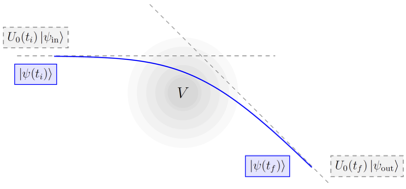
The calculation of nuclear properties from QCD, the underlying theory of the strong nuclear force, is still an open problem in physics. Effective field theories provide a possible solution by describing nuclei in terms of effective degrees of freedom; neutrons, protons, and pions. The effective description comes at a cost, namely undetermined parameters known as low-energy constants (LECs), that need to be fixed by experimental data. Furthermore, while renormalization-group (RG) invariance of predictions is a field-theoretic requirement, it is known that interaction potentials constructed with Weinberg power counting (WPC) are not RG invariant at leading order. The purpose of this thesis is to study a leading order modified Weinberg power counting potential, with additional counter terms and their associated LECs promoted to leading order. We show that the modified potential gives RG invariant predictions of nucleon-nucleon scattering phase shifts in partial waves that are otherwise problematic in WPC. Moreover, Bayesian inference is used to determine LECs from measured total scattering cross sections, which allows to account for both experimental and model uncertainties. RG-invariant predictions of scattering cross sections are demonstrated using the obtained posterior distributions of LECs. In conclusion, we find that the modified potential performs better, producing RG-invariant results for phase shifts and cross sections. We also show that total scattering cross sections do not impose very hard constraints on all LECs which calls for the inclusion of more experimental data in the inference.
Eigenvector continuation and strongly interacting cold atom systems
by Carl Eklind
2021
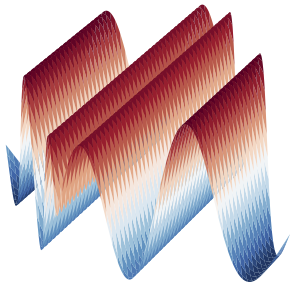
New experimental techniques have made it possible to trap and cool atoms to extremely low temperatures, which have initiated a new research field—the study of ultracold atoms. In this thesis, we consider one-dimensional many-body quantum systems of ultracold atoms with a zero-range interaction. The atoms are trapped in a tightly confining harmonic oscillator potential and the resulting Hamiltonian depends linearly on the tunable interaction strength. The aim of this study is to describe the evolution of the energy spectrum as a function of the interaction strength by exploiting eigenvector continuation—a recently developed method that has been proposed as a very efficient and accurate emulator for solving quantum many-body problems. Emulation is achieved by utilizing a limited set of calculated eigenvectors as training data to construct subspace-projected Hamiltonian matrices that can be used to approximately extrapolate the smooth eigenvector trajectory in the full Hilbert space. In this study, we show that the method of eigenvector continuation is very efficient and provides accurate predictions of the energy spectrum for both attractive and repulsive interaction strengths with just a few training vectors. The method performs extremely well for the two-particle system, where the training vectors correspond to wave functions in a relative coordinate basis, but also for the many-particle system with a basis constructed from singleparticle states. In addition, we perform an extensive analysis regarding the performance of the emulator and its dependence on the choice of training data. As a result, we propose an algorithm for finding the optimal set of training data and measure the emulator performance using K-fold cross validation.
Chiral effective theory of spin 1 dark matter direct detection
by Henric Ernbrink
2021
Dark matter (DM) is the collective name for the additional mass needed to explain the data collected from a very wide range of different astronomical observations. Everything from the velocity dispersion of galaxies, gravitational lensing caused by galaxies, the large scale structure of the universe as well as the structure of the microwave background radiation all indicate the existence of DM. The exact nature of DM is however still unknown, but it is largely believed to be new fundamental particle, outside of the current standard model of particle physics. The elusiveness of DM is largely due to the fact that the effects of DM never have been observed at microscopic scales. One promising method for detecting DM particles that permeate the galaxy is in so called direct detection experiments, in which, detectors monitor the recoils of nuclei caused by the scattering of DM which is hitting the Earth. The goal with this work is to provide new theoretical insights into the behavior of scattering between DM and nuclei. In this work DM is assumed to be a weakly interacting massive particle (WIMP) and that it is non-relativistic. Further, it is also assumed to have spin 1. The cross section for the scattering of DM against nuclei is calculated using chiral effective theory, which has not been done before for spin 1 DM. This methodology has a substantial advantage over non-relativistic theories where the degrees of freedom are limited to nucleons and DM since it also includes mesons and consequently can model the effect of meson exchange. In this work it is shown that the inclusion of the meson exchange is crucial especially when modeling the scattering of DM with heavier elements, e.g. xenon, which is a common choice in direct detection experiments. It is also shown that the non-relativistic operators that span the possible DM-nucleon interactions generally cannot be studied individually in direct detection. This is due to the fact that the interaction operators in the more general relativistic theory match onto several DM-nucleon interaction operators. Several DM-nucleon interaction operators consequently share common coupling constants and must generally be studied together.
A taste of dark portals
by Emil Åstrand
2021
Overwhelming evidence on all cosmological scales points to the inevitable existence of Dark Matter (DM), constituting approximately 85% of all matter in the Universe. The different evidence have one thing in common: they all depend on indirect, gravitational effects arising from the presence of DM. The particle nature of DM remains unknown. While the Weakly Interacting Massive Particle (WIMP) has been a promising candidate to DM, extensive direct detection searches has not yet found a conclusive signal. A possibility is that DM does not interact directly with the Standard Model (SM) but rather through an unstable mediator particle, scenarios commonly referred to as dark portals. A way to probe such models is through flavour changing rare decays of mesons, which are heavily suppressed in the SM, but receive contributions from dark portal models. In this work I consider a model where spin-1 DM is realised as a hidden U(1) symmetry, spontaneously broken by a singlet scalar that acts as the mediator and mixes with the SM Higgs field. This extension induces contributions to the branching fractions B0s,d→ l+l– where the particular ones B0s→μ+μ– and B0→μ+μ– have been measured experimentally. The contributions were found to be primarily dependent on the mixing angle alpha and the mediator mass MH1 . I find that while the most likely combination of fundamental parameters lies on the straight line sin2(alpha)/M2H 1 = 0.001 where sin(alpha) varies within [10−3, 1] and MH1 is in the range [100.5, 101.5] GeV, a large region below this line possess a flat, intermediate likelihood. This is due to the effects of H1’s presence being heavily suppressed by its mass. At the moment the analysis of constraints on spin-1 DM by rare meson decays is largely unexplored in the literature. This thesis provides first steps towards filling this gap.
Constraining a spin 1 dark matter model through CMB observations
by Alex Bökmark
2021
During the last century, overwhelming evidence has been presented to infer the existence of additional mass in the Universe, not accounted for by the observable matter content. This unknown form of matter has come to be known as Dark Matter (DM), and the leading hypothesis is that it mainly consists of new, yet-to-be discovered particles. There are different methods of probing DM, one of which is to study how annihilating DM particles would have injected energy in the early Universe and altered the appearance of the Cosmic Microwave Background (CMB) power spectrum, an approach previously used to set constraints on generic DM models. In this thesis, I investigate the prospects for using this approach to constrain certain DM model parameters. Considering a specific spin 1 DM model, the impact of its annihilation on the CMB power spectrum was investigated by implementing the model Lagrangian in GAMBIT, from which the annihilation cross section was evaluated, and used to determine the energy injected in the early Universe and how the power spectrum would have been affected. Comparing with CMB data, the likelihood for the specific set of parameter values was evaluated and then used to further sample the parameter space, allowing statistical exclusion limits to be set. Combining this with additional constraints, set from the observed DM relic density, it was possible to exclude large regions in the parameter space for the investigated model and set stringent limits on the corresponding DM mass for the specific cases considered. It was thus found that the CMB power spectrum can be used to constrain model parameters, and used in combination with relic density constraints to exclude large regions in the parameter space. Not only can these results be used in future research when considering the same model, but this thesis provides a practical example of how to implement and use GAMBIT to set constraints on model parameters from observational data, which can also be incorporated for new models in future research.
Constrained space MCMC methods for nested sampling Bayesian computations
by Jacob Olander
2020
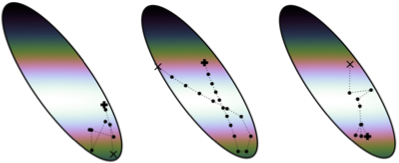
Natural phenomena can in general be described using several different scientific models, which creates a need for systematic model selection. Bayesian model comparison assigns relative probabilities to a set of possible models using the model evidence (marginal likelihood), obtained by an integral that in general needs to be evaluated numerically. Nested sampling is a conceptual framework that efficiently estimates the model evidence and, additionally, provides samples from the model parameter posterior distribution used in Bayesian parameter estimation. A vital step of nested sampling is the likelihoodconstrained sampling of the model parameter prior distribution, a task that has proven particularly difficult and that is subject to ongoing research. In this thesis we implement, evaluate and compare three methods for constrained sampling in conjunction with a nested sampling framework. The methods are variants of Markov chain Monte Carlo algorithms: Metropolis, Galilean Monte Carlo and the affine-invariant stretch move, respectively. The latter is applied in the context of nested sampling for the first time in this work. The performances of the methods are assessed by their application to a reference problem that has a known analytical solution. The problem is inspired by effective field theories in subatomic physics where the model parameters take the form of coefficients that are of natural size. We conclude that the efficiency and computational accuracy of nested sampling is strongly dependent on the choice of sampling method and the settings of its associated hyperparameters. In certain cases, especially for high-dimensional parameter spaces, the implementations of this work are seen to achieve better computational accuracy than MultiNest, a state-of-the-art nested sampling implementation extensively used in astronomy and cosmology. Generally for nested sampling, we observe that it is possible to obtain an inaccurate result without receiving any clear warning signs indicating that this is the case. However, we demonstrate that the validity of the computational results can be assessed by monitoring the sampling process.
Bayesian Model Averaging of Nuclear Mass Models
by Sebastian Lundquist
2020
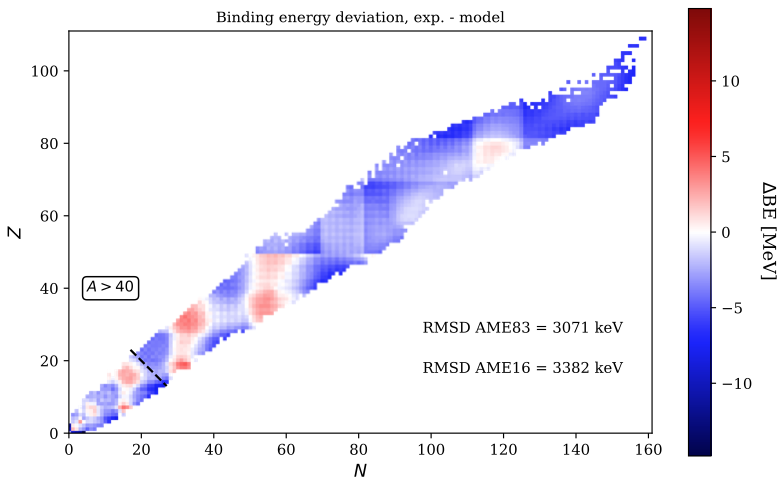
In this thesis we investigate the performance of Bayesian inference and Bayesian model averaging (BMA) applied to two nuclear mass models, the Duflo-Zuker 10 parameter model (DZ10) and the semi-empirical mass formula (SEMF). The DZ10 and SEMF models both have theoretically and experimentally motivated terms but the relative importance of them is less clear. Using Bayesian inference and BMA we have attempted to quantify model uncertainties and improve inference about nuclear masses. To explore the robustness of our BMA analysis we compare the results using different choices of parameter priors, and vary the assumed model discrepancy. The main focus is on the DZ10 model. We employ the Atomic Mass Evaluation from 1983 (AME83) for parameter estimation, then we evaluate the predictive power of the model using the Atomic Mass Evaluation from 2016 (AME16). In an attempt to determine the limits of stability of visible matter we also make a prediction for the neutron drip lines, in the tin isotopic chain (Z=50) using the DZ10 model trained on AME16. The 1-neutron drip line is predicted to neutron number N=123 [95, 125], and the 2-neutron drip line at N=115 [103, 125]. Where the error bar corresponds to a 68% degree of belief.
Prospects for the Discovery of General Dark Matter-Induced Atomic Responses
by Oskar Lindroos
2020
One of the major mysteries of modern physics is dark matter. Proposed by Fritz Zwicky in 1933, dark matter stands as the answer to several astronomical observations, but its constituents remain unkown. Since current observations only show dark matter interacting gravitationally, one can assume that the dark matter particle is a massive, weakly interacting particle also referred to as a WIMP. In an attempt to find the dark matter particle, large underground detectors have been constructed. These detectors utilise the principle of direct detection in order to detect weakly interacting particles. As the Earth passes through the halo of dark matter within the Milky Way one expects the flux of dark matter particles that arises to produce a signal within these experiments. However, so far a signal that cannot be anything other than dark matter remains to be found. This thesis will present the sensitivities for future direct detection experiments under the assumption of general dark matter-electron interactions. We provide the underlying theory of a model describing general dark matter-electron interactions in the non-relativistic frame which we use to simulate event rates in active experiments. Based on the null results in current experiments, we perform a statistical analysis in order to find the lowest detectable coupling constant for different sets of interactions corresponding to a specific dark matter particle mass. We express the sensitivity of future direct detection experiments in terms of statistical significance for signal discovery.
Rejecting P and CP-invariance in scalar dark matter-nucleus interactions
by Joakim Hagel
2020
There is convincing evidence that a significant fraction of the mass in our Universe consists of non-baryonic and non-luminous dark matter. The particles forming this cosmological component have so far escaped detection, but are currently searched for at direct detection experiments. These search for non-relativistic dark matternucleus scattering events in low-background, deep underground detectors. In this thesis, the properties of spin-0 dark matter-nucleus interactions under P and CP transformations are investigated, assuming that a dark matter signal has been observed at direct detection experiments. Using an effective theory to describe these interactions, the scattering events can be restricted to three cases: Conserving CP and P; Conserving CP, but violating P; and violating both CP and P. By performing a likelihood ratio test with simulated data, this thesis aims to determine how many observed scattering events are required in order to discriminate one case from the other in the next generation of direct detection experiments.
Spin Dependent Discrimination between Majorana and Dirac Dark Matter
by Erik Johansson
2019
A large number of observations reveal deviations from expected gravitational behaviour in astrophysical systems. This suggests that something is missing in our understanding of the Universe. A well established candidate for explaining these deviations is dark matter, a kind of matter that is not subject to photon interactions and thus can not be detected by absorbed or emitted light – it is dark. Even though we can not observe it at any detectable wavelength, dark matter is postulated to interact via gravitation. These interactions would then account for the shortcoming of gravitational pull from visible mass, explaining the observed irregular gravitational behaviour. One leading hypothesis is that the proposed dark matter component of the Universe is actually made out of massive, weakly interacting particles. As of today, there has not yet been any detection of such a particle, leaving the fundamental properties of dark matter unknown. There are currently several ongoing experimental projects searching for dark matter particles, and more are being planned. Furthermore, their accuracy is higher than ever, and if the dark matter particle hypothesis is correct, it is reasonable to expect a detection signal in the foreseeable future. The different searches take complementary approaches and exploit either annihilation, production or direct de- tection experiments. The latter, which is the focus of this thesis, aims to detect dark matter by measuring the recoil of a target nucleus in a detector when a dark matter particle scatters off of it. In case of positive detection at direct detection experiments, a model describing the interaction between dark matter particles and baryonic matter is needed in order to be able to draw conclusions about the dark matter particle properties. Under the assumption that dark matter is a spin 1/2 particle that only interacts with baryonic matter via spin dependent interactions, this thesis studies dark matter-nucleus scattering in order to see if it is feasible to discriminate between Majorana and Dirac dark matter. I find that, if dark matter particles are detected at three different experiments, the Majorana dark matter hypothesis can be rejected in favour of an alternative hypothesis in which dark matter is a Dirac particle. Restrictions on target elements that are of interest for this test are presented, and the test procedure is studied for setups containing some of them, namely: 131Xe, 127I, 73Ge, 23Na and 19F.
Particle/Antiparticle Nature of Light Dark Matter in Direct Detection
by Julia Ravanis
2019
In the last century, astronomers have concluded that the luminous mass in the Universe impossibly can be responsible for the huge gravitational pull observed in stellar and galactic systems. The explanation for this discrepancy between luminous mass and gravitational e ects is believed to be dark matter { an unknown particle species that does not emit or absorb light at detectable wavelengths. Although extensive e orts have been made to detect this mysterious particle, it remains undiscovered, and its nature is one of the greatest unsolved questions in fundamental physics. This thesis investigates the prospects of discriminating between Dirac and Majorana dark matter, if dark matter is to be found in direct detection experiments. The Dirac or Majorana nature of a particle corresponds to the existence or absence of a distinct antiparticle, which for the invisible, and therefore probably neutral, dark matter particle is a property of major importance. The theoretical framework is fermionic dark matter at the sub-GeV mass scale, interacting with electrons in direct detection experiments with argon, xenon and germanium targets. The coupling constant parameter space of photon mediated interactions is explored, and the regions where statistical rejection of a Majorana hypothesis could be possible in the future are determined. It is found that the discrimination signi cance for rejecting a Majorana hypothesis, given simulated Dirac-like experimental signals, reaches values of >4 standard deviations for a substantial part of the coupling constant parameter space for germanium targets, whereas argon and xenon targets entail stronger restrictions on the discrimination parameter space. The discrimination signi cance is highly dependent on the available detection energy region, and the dark matter mass.
Theory of Polarized Direct Dark Matter Detection
by Kåre Fridell
2018
There are reasons to believe that a large fraction of the mass in our universe consists of an elusive, so far undiscovered, form of matter, known as dark matter. Dark matter is thought to reside in halos surrounding galaxies and galaxy clusters. Evidence for the existence of dark matter comes from astrophysical observations, and many of these observations suggest that dark matter is non-relativistic, and that it interacts with ordinary matter with a strength on the weak scale. Several experimental searches are currently operating to find dark matter on Earth as it interacts with ordinary matter in detectors, a technique known as direct detection. In this thesis, the possibilities of using a polarized detector to search for dark matter is explored. Both spin 12 and spin 1 dark matter particles are considered, in the context of their interaction with a polarized nucleus. Calculations are performed for the case where dark matter interacts with a point-like spin 12 nucleus via a massive boson, and the expected experimental signals that such an interaction would provide are evaluated. The calculations are done in a non-relativistic effective field theory, and only tree level diagrams are considered. For both spins, the dark matter-nucleus interaction depends on the orientation of polarization. A discrepancy is seen between the two spins, and it may be possible to distinguish between them in a polarized direct de- tection experiment. The distribution of recoil events shows an inhomogeneity due to the angle of polarization with respect to the velocity of the Earth through the dark matter halo. It is possible to distinguish between the two spins even without direc- tional information, if the rate of events is related to the recoil energy experienced by the nucleus. The polarization dependence is found to be suppressed as a consequence of the low velocities of the dark matter particles, and exposures greater than that of current experiments are needed in order to probe the polarization dependent effects. If dark matter is a spin 12 particle, the degree of polarization dependence varies with the amount of parity violation in its interaction with nuclei. If dark matter is a spin 1 particle, the polarization dependence would vary depending on the appearance of its interaction Lagrangian with ordinary matter, and polarized effects could be seen at smaller exposures if certain criteria are met, such as the relative strength between different coupling constants being sufficiently great.
Prospects for dark matter detection with next generation neutrino telescopes
by Anton Bäckström
2018
There are strong hints that around a fourth of the energy content of the Universe is made up of dark matter. This type of matter is invisible to us, since it does not interact via the electromagnetic force. One of the leading theories suggests that this type of matter consists of Weakly Interacting Massive Particles (WIMPs), particles with mass around 10-1000 GeV that only interact with baryonic matter via the weak nuclear force and gravitation. If this theory is true, dark matter should be gravitationally attracted toward the Sun, inside which collisions with baryonic matter have a possibility to slow down the particles to speeds below the escape velocity. As these dark matter particles are captured by the Sun, they will continue to collide with baryonic particles and lose more energy until they settle in the core of the Sun. When the concentration of dark matter particles is sufficiently high in the core, they will self-annihilate with each other, resulting in the creation of Standard Model particles which eventually will decay into neutrinos. These neutrinos will escape the Sun and can possibly be detected in a neutrino telescope. One such telescope is Ice- Cube located at the South Pole, consisting of detectors placed in a cubic kilometer of ice. There is a plan to upgrade this telescope which is called Precision IceCube Next Generation Upgrade (PINGU). In my thesis I have investigated the sensitivity of PINGU to the strength of interactions between dark matter and baryonic matter. The analysis have been performed for the 28 lowest order operators in a non-relativistic effective field theory for a dark matter particle with spin half, annihilating into either b¯b or τ τ¯ which decays into νµ and ν¯µ. I have found that PINGU will improve current IceCube exclusion limits on the coupling constant of the theory for a dark matter mass less than 100 GeV for the b¯b channel and less than 40 GeV for the τ τ¯ channel, after just one year of data taking, for all 28 operators.
Inelastic Dark Matter: Theory and Detection Prospects
by Fredrik Hellström
2018
A wealth of cosmological observations indicate the existence of invisible mass, or dark matter (DM), in the Universe. The currently leading hypothesis is that DM consists of as of yet undetected particles with interactions at the weak scale. Weakly interacting DM particles are currently searched for using direct detection experiments, which look for nuclear recoils induced by the non-relativistic scattering of DM particles in low-background detectors, and indirect detection experiments, which search for DM annihilation signals produced in space or at the center of the Sun, where DM is expected to be gravitationally captured as a result of DM-nucleus scattering. Neutrino telescopes searching for neutrinos from DM annihilation in the Sun are an important example of indirect detection experiments. As of yet, DM has not been definitively detected at any experiment. The absence of such a detection constrains the allowed DM parameter space, and many popular DM candidates are under pressure. A possible explanation for the non-detection is that DM predominantly scatters inelastically with nuclei, implying a mass-splitting between the initial and final states of the DM particle. This type of model, called inelastic DM, would be harder to detect with current experiments due to the altered kinematics and has recently attracted a great deal of attention. In this thesis, I explore the theory and detection prospects of inelastic DM in more generality than has been done before. For the first time, I calculate the rate at which the Sun captures DM particles in the general effective theory of inelas- tic DM. Using this calculation, I derive novel limits on the coupling coefficients of inelastic DM from the null results of the neutrino telescope IceCube. Furthermore, I calculate corresponding limits from the null results of the direct detection experiments CRESST, PICO-60 and XENON1T. My results show that neutrino telescopes are the most competitive type of detection experiment for part of the parameter space for almost all inelastic DM interaction types. They also provide the insight that neutrino telescopes are indispensable when highly inelastic DM is considered, highlighting an as of yet unexploited complementarity between direct detection experiments and neutrino telescopes.
Three-Nucleon Forces Through Normal-Ordered Approximations
by Dag Fahlin Strömberg
2016
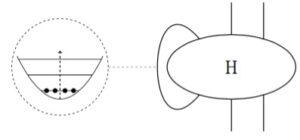
Three-body forces have long been known to play an important role in nuclear physics. However, fully including such interactions in ab-initio methods is computationally expensive and not feasible for larger nuclei. As an alternative, approximations based on normal-ordering with respect to a Fermi state of the nucleus can be used. In this framework part of the three-body interaction can be expressed as lower order interactions, which can be included without increasing the computational complexity. This thesis provides a full derivation of the normal-ordered two-body (NO2B) approximation for closed-shell nuclei. In addition, a simple implementation of this method is described. This is then used to calculate ground states of helium-4 in small model spaces, which are compared to the corresponding calculations with full three-body forces. The results show a relative error of less than 1.5%, in line with earlier studies.
Three-Body Forces in Configuration-Interaction Methods for Nuclear Physics
by Tor Djärv
2016
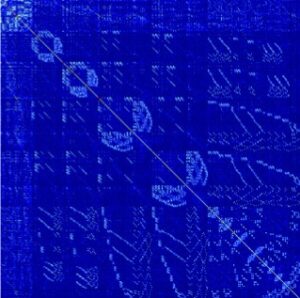
In this thesis, three-body forces are studied and implemented in a quantum many- body configuration-interaction method. The general importance of three-body forces in physics is discussed, providing some classical examples, before focusing in particular on their appearance in modern nuclear physics. The theoretical formalism that is needed for the implementation of three-body forces in quantum many-body systems is presented, with the angular-momentum coupling of two- and three-body systems of identical particles as main focus point. The resulting software, that is written in C, is then utilized to compute the ground-state energy of the tritium (3H) and helion (3He) nuclei in finite model spaces (Nmax ≤ 8). Results are compared with other simulations and the difference is within an acceptable tolerance. A few suggestions for future optimization of the code, such as the utilization of hash maps, are discussed.
Properties of dark matter from ring-like features in the effective field theory of directional dark matter detection
by Christian Döring
2016
Even though the theoretical concept of particle dark matter has been developed several decades ago, its existence is still not experimentally determined. A promising technique is direct detection, especially for the popular dark matter candidate which is a weakly interacting massive particle (WIMP). The elastic scattering process in a direct detector is theoretically described by a non-relativistic effective field theory, which consists of 14 non-relativistic quantum operators. They describe spin- dependent and spin-independent interactions. In this thesis we aim to obtain the number of recoil events needed, in order to distinguish between the recoil spectra of two operators. Additionally we aim to constrain the spin of the WIMP statistically from a given measurement. Therefore we perform a full map based likelihood-ratio test. We compare a realistic, directional measurement with the recoil-event distribution predicted by the non-relativistic operators from the effective theory. Thereby we make explicit use of ring-like features occurring in the recoil-rate distribution of specific operators. We account for the limited directional resolution of the detectors by simulating the measurement distribution on a angular grid. We show that two interactions due to two different non-relativistic operators can be distinguished on a 2σ level with O(250 − 500) recoil events. We compare this with recently published results that already addressed this question. In contrast to the published results we use the full effective theory without any further approximations and extend the likelihood-ratio analysis to a map based ratio test. Finally we show as a new result that the spin of the WIMP can be obtained by applying the likelihood-method to a specific choice of operators on a 3σ level with O(1000) recoil events and including background events. In this way we highlight the connection to the underlying relativistic models, from which the effective operators can be obtained in the non- relativistic limit. Our results underline the advantages of directional information in order to determine dark matter properties from direct detector measurements.
Dark Matter Capture by the Sun via Self-Interaction
by Axel Widmark
2016
There is compelling evidence that dark matter constitutes 85 % of the universe’s total matter content. So far, this distinctly different type of particle is observed only in terms of its gravitational effects, but various detection experiments are conducted and underway. One method is indirect detection of neutrinos coming from the Sun. Under the assumption that dark matter consists of Weakly Interacting Massive Particles (WIMPs), one of the most studied dark matter particle candidates, these WIMPs would interact with atomic nuclei within the Sun and be trapped in its gravitational field. After a large enough concentration of trapped WIMPs has been amassed, they would begin annihilating with each other, producing a high-energy neutrino signal. In this thesis I study the possibility that WIMP self-interaction has a significant effect on the total capture rate and resulting neutrino signal. Potentially, an amassed concentration of WIMPs inside the Sun can itself constitute a scattering target and contribute to further captures from the galactic dark matter halo. In order to describe the kinematics of particle interaction and WIMP capture I utilize an effective field theory in the non-relativistic limit. This allows me to explore, in a model-independent way, the parameter space of interaction and the possibility for WIMP capture enhancement due to self-interaction. Upper limits to the strength of these interactions come from direct detection experiments and galaxy cluster observation and simulation. It is found that self-interaction could play a signficant role in amplifying the neutrino signal; even an amplification of several orders of magnitude is not ruled out by current limits.
Tunneling Theory for Few-Body Systems in One-Dimensional Traps
by Rikard Lundmark
2014
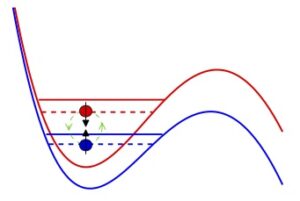
In recent experiments, carried out at the University of Heidelberg, tunneling rates of ultracold distinguishable fermions out of an optomagnetical trap have been measured. The fermions interact by a tunable short-ranged interaction, and the trap is asymmetric making the trapped quantum system effectively one-dimensional. In this thesis, a method for calculating the energy levels and tunneling rates of one and two interacting particles out of a very general onedimensional potential well is devised. The method is based on expanding the Schrˆdinger equation of the system in a complex-momentum basis. This is done utilizing the so-called Berggren completeness relation. Ultimately, the basis expansion leads to a complex symmetric non-Hermitian eigenvalue problem for a large, dense matrix. The general method is applied to a system of trapped, ultracold fermionic atoms in a setup that closely resembles the Heidelberg experiments. The short-ranged interaction is modeled as a point-interaction, and the trap potential is regularized at large distances from the interesting region. The obtained energies and decay rates are contrasted to results obtained using the Wentzel-Kramers-Brillouin (WKB) approximation. Notable differences can be observed, and these may be due to insufficiency of the WKB approximation to accurately describe the system in question.
Fermionization in one-dimensional cold atom systems
by Jonathan Lindgren
2013
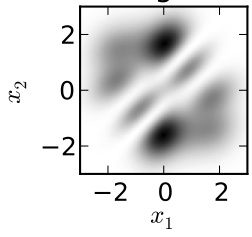
Recent developments in experimental techniques have made it possible to use magnetic fields to tune interactions between trapped cold atoms with different spin components allowing for detailed experimental investigations of the properties of quantum mechanical few-body systems. In this thesis we investigate the properties of two-component cold atoms trapped in a harmonic oscillator potential with a zero range interaction of arbitrary strength between the different species. In the limit of infinite interaction the atoms will tend to avoid each other. This is reminiscent of the Pauli principle and we will address differences and similarities to a system of identical fermions. Exact diagonalization of the Hamiltonian in a harmonic oscillator basis is used to obtain the eigenvectors and eigenvalues of the system and we also employ numerical methods borrowed from nuclear physics to generate effective interactions using unitary transformations. This method proves to be very effective for improving the convergence and the computation time is significantly decreased even for very strongly interacting systems.
The Similarity Renormalization Group for three bosons in a momentum-space partial-wave basis
by Boris Carlsson
2012
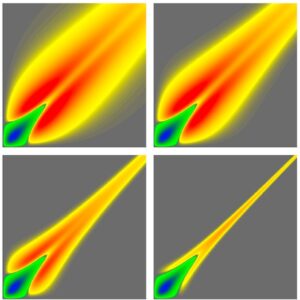
The Similarity Renormalization Group (SRG) flow equation is explored for systems of two and three spinless bosons in a momentum-space partial-wave basis. The two- and three-body binding energies as well as the phaseshifts are used to gauge that the transformation is unitary and to study how well the SRG decouples high- and low-energy physics. I consider four different potentials with different characteristics: Two simplied nucleon potentials and two inter-atomic helium potentials (a soft-core potential and the state-of-the-art LM2M2 potential that is fitted to a wealth of experimental data). An initial three-body force is included for two of these potentials. Even with only two-body terms in the initial hamiltonian, SRG induced many-body forces are shown to arise during the transformation. These induced forces are computed for the three-body system and their evolution is studied as a function of the flow parameter. In all cases the SRG transformed potentials display greatly improved decoupling. This is achieved with a three-body binding-energy deviation of less than 0.1% in all cases except for the soft-core helium potential.
Chiral Perturbation Theory,Weak Interactions and the Nuclear Two-body Axial Vector Current
by Jonathan Karlsson
2012
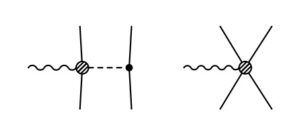
In this thesis I give a practical introduction to chiral perturbation theory. This is an effective field theory of pions and nucleons. It is governed by the chiral symmetry stemming from the lightness of the up- and down quarks in quantum chromodynamics. The validity region comprises energies up to the rho meson mass. The theory is expressed as an infinite series of chiral invariant interactions, whose strengths are expressed in an infinite number of low energy constants. The interactions can be ordered and I identify the most important ones. Special care has to be taken when including nucleons in chiral perturbation theory because of the scale introduced by the nucleon mass. To facilitate straightforward calculations I work in heavy-baryon chiral perturbation theory. In this formalismthe nucleons are considered to be very heavy and the nucleon mass only appears in next-to-leading order corrections. The pions and nucleons are coupled to the charged vector bosons of the weak interactions. This interaction is determined entirely by the chiral symmetry. As an example, I compute the decay rate of charged pions. Experimental data for this observable can be used to fix one low energy constant. Finally, I compute the two-body axial vector current of nucleons in heavybaryon chiral perturbation theory with the long wavelength approximation. This current complements the leading order one-body current operator and gives the first correction to the Gamow-Teller operator from the nuclear environment. I provide both a detailed derivation and an explicit expressions for this two-body current operator.
Chiral Extensions of the MSSM
by Denis Karateev
2012
This thesis is based on the paper [1]. We present the construction and analysis of supersymmetric models. We begin by giving a short description of the Minimal Supersymmetric Standard Model (MSSM) and pointing out its two main problems. Motivated to resolve them we construct a class of MSSM extensions characterized by a fully chiral field content (no -terms) and no baryon or lepton number violating terms in the superpotential due to an extra U0(1) gauge symmetry. The minimal models consist of the usual matter sector with family dependent U0(1) charges, six Higgs weak doublets, and four charged singlets required to give masses to the Higgsinos, cancel anomalies and allow for commensurate charges. These models are characterized by a discrete set of solutions for the charges. The models with right handed neutrino superfields are also presented. As a different issue we briefly discuss the SUSY breaking mechanism in gauge mediation scenario, where we show how an extra gaugino ~ Z0 can be used to mediated SUSY breaking from the Hidden Sector. Analysing the models, we discuss their general features, e.g. classical vacuum, CPviolation, Electro-Weak symmetry breaking and running coupling constants. In the end we investigate the decays of Z and Z0 -bosons and study in detail experimental constraints on Flavour Changing processes.